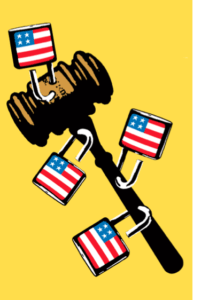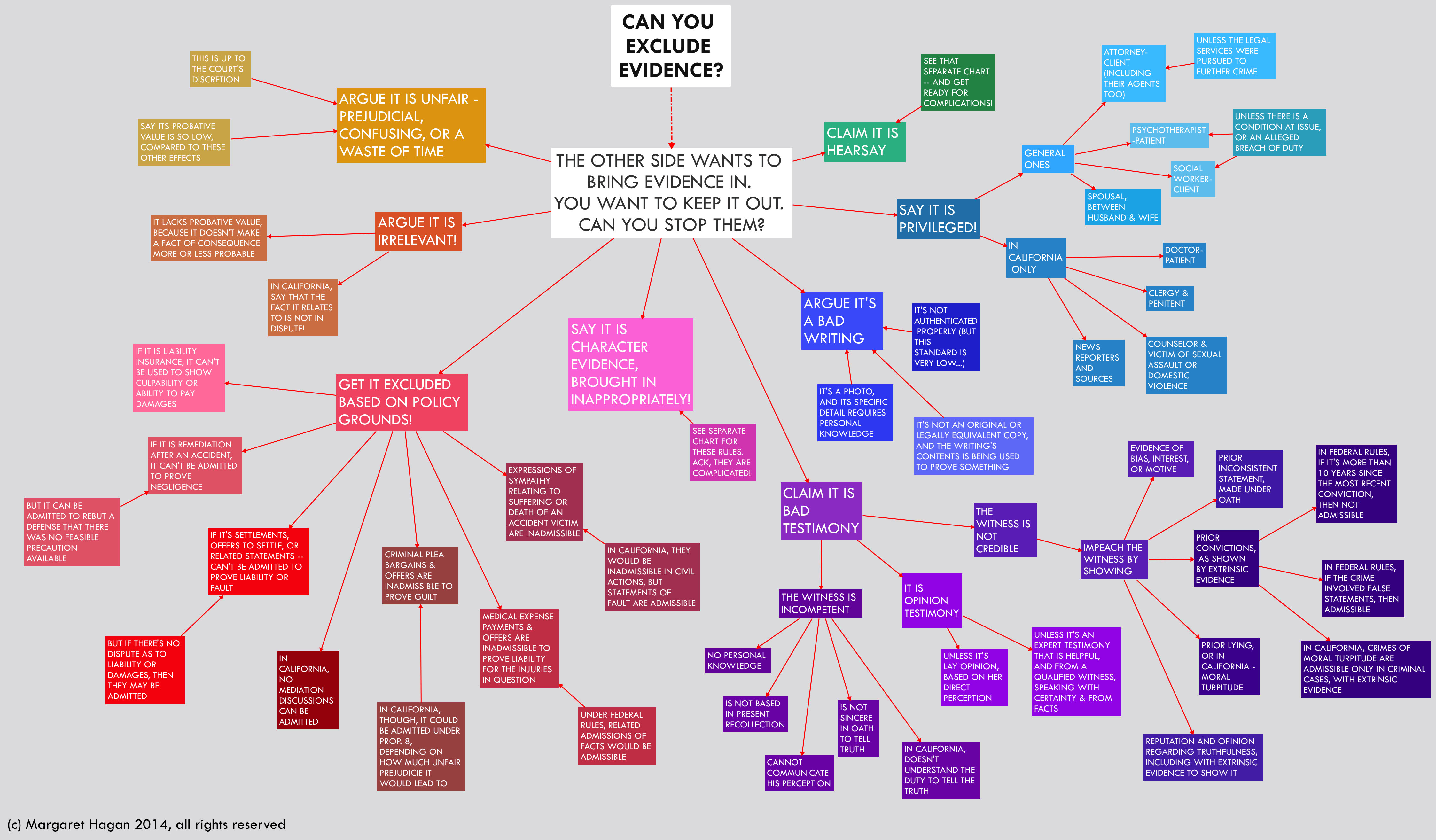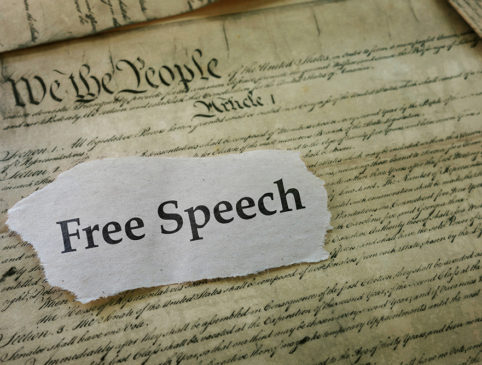Hartman v. Moore (2006) –
Retaliatory Prosecution Claims Against Government Officials –
1st Amendment
By David L. Hudson Jr.
Hartman v. Moore, 547 U.S. 250 (2006), is a decision by the Supreme Court of the United States involving the pleading standard for retaliatory prosecution claims against government officials. After a successful lobbying attempt by the CEO of a manufacturing company against competing devices that the US Postal Service supported, the CEO found himself the target of an investigation by US postal inspectors and a criminal prosecution that was dismissed for lack of evidence. The CEO then filed suit against the inspectors and other government officials for seeking to prosecute him in retaliation for exercising his First Amendment rights to criticize postal policy. The Court ruled 5-2 that to prove that the prosecution was caused by a retaliatory motive, the plaintiff bringing such a claim must allege and prove that the criminal charges were brought without probable cause.
In Hartman v. Moore, 547 U.S. 250 (2006), the Supreme Court ruled that plaintiffs alleging federal civil claims—in this case, violation of First Amendment expressive rights— for retaliatory prosecution must prove the absence of probable cause for the retaliation as an essential element of their claims.
Moore criticized postal service for not using his new technology
The case involved William G. Moore Jr., the chief executive officer of a company that offered multiple optical character readers that would enable the U.S. Postal Service to read and sort mail much quicker than with its standard single-line scanning machines. Moore had lobbied Congress, testified before committees, and engaged in other First Amendment–protected activity that criticized the postal service for not using the new technology.
Postal Service investigated Moore for criminal charges
The U.S. Postal Service eventually employed this new technology but entered into a contract with one of Moore’s competitors. Postal inspectors then investigated Moore to determine whether he had participated in a kickback scheme with a postal service governor. The postal inspectors urged that criminal charges be brought against Moore and his company, but after a six-week trial, a federal district court dismissed the charges, finding a “complete lack of direct evidence” linking Moore to criminal wrongdoing.
Moore claimed investigation was retaliation for exercising his First Amendment rights
Moore then filed a federal civil claim under Bivens v. Six Unknown Fed. Narcotics Agents (1971), alleging retaliation for the exercise of his First Amendment rights. He claimed that the prosecutor and postal inspectors had engineered the investigation because he had publicly criticized the U.S. Postal Service. A federal court granted the prosecutor immunity, but the claims against the postal inspectors continued. The inspectors contended that the claims against them must fail because Moore must prove a lack of probable cause. Moore countered that he need only show that a substantial factor in the decision to bring the unfounded criminal charges was retaliation for his protected activities.
Court said Moore had to show lack of probable cause for the investigation
By a 5-2 vote (Chief Justice John G. Roberts Jr. and Justice Samuel A.Alito Jr. did not participate), the Supreme Court ruled that a plaintiff alleging retaliatory prosecution under Bivens or under 42 U.S.C. section 1983 must show a lack of probable cause. Writing for the majority, Justice David Souter explained, “Because showing an absence of probable cause will have high probative force, and can be made mandatory with little or no added cost,it makes sense to require such a showing as an element of a plaintiff’s case, and we hold that it must be pleaded and proven.”
Justice Ruth Bader Ginsburg, joined by Justice Stephen Breyer, dissented, noting that the record in the case showed that the postal inspectors engaged in “unusual prodding” of the prosecutor to institute criminal charges against Moore. Ginsburg reasoned that requiring a lack of probable cause will deter “only entirely baseless prosecutions” and allow “retaliators” to pursue many claims that should not be brought. She agreed with the federal appeals court standard that allows retaliatory prosecution claims where the plaintiff shows “strong motive evidence combine(d) with weak probable cause” and that the claim would not have been brought but for the retaliatory animus.
David L. Hudson, Jr. is a law professor at Belmont who publishes widely on First Amendment topics. He is the author of a 12-lecture audio course on the First Amendment entitled Freedom of Speech: Understanding the First Amendment (Now You Know Media, 2018). He also is the author of many First Amendment books, including The First Amendment: Freedom of Speech (Thomson Reuters, 2012) and Freedom of Speech: Documents Decoded (ABC-CLIO, 2017). This article was originally published in 2009.
cited https://www.mtsu.edu/first-amendment/article/847/hartman-v-moore
Facts of the case
William Moore sued six postal inspectors in federal court, alleging that they had brought criminal charges against him in retaliation for lobbying efforts he undertook on behalf of his company. The inspectors claimed that they had qualified immunity (that is, because they filed the charges in their official capacity on good faith, they could not be sued) and also that the case should be dismissed because they had probable cause to charge Moore. The district court sided with Moore, and the Court of Appeals for the District of Columbia agreed, finding that, even with probable cause, they must show that that the prosecution was not motivated by a desire for retaliation.
Question
Are law enforcement agents liable for retaliatory prosecution in violation of a defendant’s First Amendment free speech rights when the prosecution was supported by probable cause?
Conclusion
Sort:
-
5–2 DECISION FOR MICHAEL HARTMAN, FRANK KORMANN, PIERCE MCINTOSH, NORMAN ROBBINS, AND ROBERT EDWARDS

John G. Roberts, Jr. 
John Paul Stevens 
Antonin Scalia 
Anthony M. Kennedy 
David H. Souter 
Clarence Thomas 
Ruth Bader Ginsburg 
Stephen G. Breyer 
Samuel A. Alito, Jr.
No. In a 5-2 decision, the Court ruled in favor of the postal inspectors, overruling the Court of Appeals. The opinion by Justice David Souter held that plaintiffs alleging retaliatory prosecution must prove that the law enforcement agents lacked probable cause. Probable cause, the Court ruled, is a crucial component of the “chain of causation” needed to evaluate retaliatory prosecution charges. Justice Ginsburg wrote a dissent, which Justice Breyer joined. Chief Justice Roberts and Justice Alito took no part in the decision. cited https://www.oyez.org/cases/2005/04-1495
SYLLABUS
OCTOBER TERM, 2005
HARTMAN V. MOORE
SUPREME COURT OF THE UNITED STATES
HARTMAN et al. v. MOORE
certiorari to the united states court of appeals for the district of columbia circuit
No. 04–1495. Argued January 10, 2006—Decided April 26, 2006
Seeking to convince the United States Postal Service to incorporate multiline optical scanning technology, a company (REI), which manufactured multiline optical readers, commenced an extensive lobbying and public-relations campaign. In the end, the Postal Service begrudgingly embraced the multiline technology, but awarded the lucrative equipment contract to a competing firm. Subsequently, Postal Service inspectors investigated REI and its chief executive, respondent Moore, for their alleged involvement in a consulting-firm kickback scandal and for their alleged improper role in the search for a new Postmaster General. Urged at least in part by the inspectors to bring criminal charges, a federal prosecutor tried REI and its top officials. But, finding a complete lack of evidence connecting them to any wrongdoing, the District Court acquitted the defendants. Moore then filed an action under Bivens v. Six Unknown Fed. Narcotics Agents, 403 U. S. 388, against the federal prosecutor and petitioner postal inspectors, arguing, as relevant here, that they had engineered the prosecution in retaliation for his lobbying efforts. The claims against the prosecutor were dismissed in accordance with the absolute immunity for prosecutorial judgment. Ultimately, the entire suit was dismissed, but the Court of Appeals reinstated the retaliatory-prosecution claim against the inspectors. Back in District Court, the inspectors moved for summary judgment, claiming that because the underlying criminal charges were supported by probable cause they were entitled to qualified immunity. The District Court denied the motion, and the Court of Appeals affirmed.
Held: A plaintiff in a retaliatory-prosecution action must plead and show the absence of probable cause for pressing the underlying criminal charges. Pp. 5–15.
(a) As a general matter, this Court has held that the First Amendment prohibits government officials from subjecting an individual to retaliatory actions, including criminal prosecutions, for speaking out. Crawford-El v. Britton, 523 U. S. 574, 592. When nonretaliatory grounds are insufficient to provoke the adverse consequences, retaliation is subject to recovery as the but-for cause of official injurious action offending the Constitution, see, e.g., id., at 593, and a vengeful federal officer is subject to damages under Bivens. Pp. 5–6.
(b) Although a Bivens (or 42 U. S. C. §1983) plaintiff must show a causal connection between a defendant’s retaliatory animus and subsequent injury in any retaliation action, the need to demonstrate causation in the retaliatory-prosecution context presents an additional difficulty which can be overcome by a showing of the absence of probable cause. In an ordinary retaliation case, the evidence of motive and injury are sufficient for a circumstantial demonstration that the one caused the other, and the causation is understood to be but-for causation, without which the adverse action would not have been taken. When the claimed retaliation is, however, a criminal charge, the action will differ in two ways. First, evidence showing whether there was probable cause for the criminal charge will be highly valuable circumstantial evidence to prove or disprove retaliatory causation. Demonstrating a lack of probable cause will tend to reinforce the retaliation evidence and show that retaliation was the but-for basis for instigating the prosecution, while establishing the existence of probable cause will suggest that the prosecution would have occurred even without a retaliatory motive. Second, since the defendant in a retaliatory-prosecution case will not be the prosecutor, who has immunity, but an official who allegedly influenced the prosecutorial decision, the causal connection required is not between the retaliatory animus of one person and that person’s own injurious action, as it is in the ordinary retaliation case, but between the retaliatory animus of one person and the adverse action of another. Because evidence of an inspector’s animus does not necessarily show that the inspector induced the prosecutor to act when he would not have pressed charges otherwise and because of the longstanding presumption of regularity accorded prosecutorial decisionmaking, a showing of the absence of probable cause is needed to bridge the gap between the nonprosecuting government agent’s retaliatory motive and the prosecutor’s injurious action and to rebut the presumption. Pp. 6–13.
(c) The significance of probable cause or the lack of it looms large, being a potential feature of every case, with obvious evidentiary value. Though not necessarily dispositive, the absence of probable cause along with a retaliatory motive on the part of the official urging prosecution are reasonable grounds to suspend the presumption of regularity behind the charging decision and enough for a prima facie inference that the unconstitutionally motivated inducement infected the prosecutor’s decision to go forward. Pp. 13–15.
388 F. 3d 871, reversed and remanded.
Souter, J., delivered the opinion of the Court, in which Stevens, Scalia, Kennedy, and Thomas, JJ., joined. Ginsburg, J., filed a dissenting opinion, in which Breyer, J., joined. Roberts, C. J., and Alito, J., took no part in the consideration or decision of the case. cited https://supreme.justia.com/cases/federal/us/547/250/
Learn more about these sujects
- Malicious Prosecution
- Prosecutional Misconduct
- Vindictive Prosecution
- Retaliatory Prosecution
- Abuse of Process
Selected Issues in Malicious Prosecution Cases
Malicious Prosecution / Prosecutorial Misconduct
Vindictive Prosecution – Georgetown University
VINDICTIVE AND SELECTIVE PROSECUTION
What is Abuse of Process?
Defeating Extortion and Abuse of Process in All Their Ugly Disguises
What’s the Difference between Abuse of Process and Malicious Prosecution?
Malicious Prosecution Actions Arising Out Of Family Law Proceedings: Proceed Carefully
Frivolous, Meritless or Malicious Prosecution
SCOTUS Makes It Easier To Sue Police And Prosecutors For Malicious Prosecution
Prosecutional Misconduct – SCOTUS Rulings re: Prosecutors
National District Attorneys Association – National Prosecution Standards – NDDA
What Happens If Charges Are Dropped Before Trial?
Functions and Duties of the Prosecutor – Prosecution Conduct
Possible courses of action Prosecutorial Misconduct
Misconduct by Judges & Prosecutor – Rules of Professional Conduct
PC 1385 – Dismissal of the Action for Want of Prosecution or Otherwise
Thomp$on v. Clark – Maliciou$ Pro$ecution
Reichle v. Howards (2012) – Retaliatory Prosecution Claims Against Government Officials –1st Amendment
People v. Superior Court (Greer) 5th & 8th Amendment – Bias / Malicious Persecutor
Hartman v. Moore (2006) –Retaliatory Prosecution Claims Against Government Officials – 1st Amendment
What is a Fiduciary Duty; Breach of Fiduciary Duty
Epic SCOTUS Decisions
To Learn More…. Read MORE Below and click the links
Abuse & Neglect – The Reporters (Police, D.A & Medical & the Bad Actors)
If You Would Like to Learn More About: The California Mandated Reporting Law Click Here
To Read the Penal Code § 11164-11166 – Child Abuse or Neglect – California Penal Code 11164-11166
Child Abuse and Neglect Reporting Act Article 2.5. (CANRA) Click Here
Mandated Reporter formclick linkMandated Reporter FORM SS 8572.pdf – The Child Abuse
ALL POLICE CHIEFS, SHERIFFS AND COUNTY WELFARE DEPARTMENTS
INFORMATION BULLETIN Click H ere Officers and DA’s for (Procedure to Follow)
It Only Takes a Minute to Make a Difference in the Life of a Child
Learn More About True Threats Here below….
We also have the The Brandenburg v. Ohio (1969) – 1st Amendment
CURRENT TEST = We also have the The ‘Brandenburg test’ for incitement to violence – 1st Amendment
We also have the The Incitement to Imminent Lawless Action Test– 1st Amendment
We also have the True Threats – Virginia v. Black is most comprehensive Supreme Court definition – 1st Amendment
We also have the Watts v. United States – True Threat Test – 1st Amendment
We also have the Clear and Present Danger Test – 1st Amendment
We also have the Gravity of the Evil Test – 1st Amendment
We also have the Elonis v. United States (2015) – Threats – 1st Amendment
Learn More About What is Obscene…. be careful about education it may enlighten you
We also have the Miller v. California – 3 Prong Obscenity Test (Miller Test) – 1st Amendment
We also have the Obscenity and Pornography – 1st Amendment
Learn More About Police, The Government Officials and You….
$$ Retaliatory Arrests and Prosecution $$
We also have the Brayshaw v. City of Tallahassee – 1st Amendment – Posting Police Address
We also have the Publius v. Boyer-Vine –1st Amendment – Posting Police Address
We also have the Lozman v. City of Riviera Beach, Florida (2018) – 1st Amendment – Retaliatory Police Arrests
We also have the Nieves v. Bartlett (2019) – 1st Amendment – Retaliatory Police Arrests
We also have the Hartman v. Moore (2006) – 1st Amendment – Retaliatory Police Arrests
Retaliatory Prosecution Claims Against Government Officials – 1st Amendment
We also have the Reichle v. Howards (2012) – 1st Amendment – Retaliatory Police Arrests
Retaliatory Prosecution Claims Against Government Officials – 1st Amendment
Learn More About Police, The Government Officials and You….
We also have the Freedom of the Press – Flyers, Newspaper, Leaflets, Peaceful Assembly – 1st Amendment
We also have the Insulting letters to politician’s home are constitutionally protected, unless they are ‘true threats’ – 1st Amendment
We also have the Introducing TEXT & EMAIL Digital Evidencein California Courts – 1st Amendment
We also have the First Amendment Encyclopedia very comprehensive – 1st Amendment
ARE PEOPLE LYING ON YOU? CAN YOU PROVE IT? IF YES…. THEN YOU ARE IN LUCK!
We also have the Penal Code 118 PC – California Penalty of “Perjury” Law
We also have the Federal Perjury – Definition by Law
We also have the Penal Code 132 PC – Offering False Evidence
We also have the Penal Code 134 PC – Preparing False Evidence
We also have the Penal Code 118.1 PC – Police Officers Filing False Reports
We also have the Spencer v. Peters– Police Fabrication of Evidence – 14th Amendment
We also have the Penal Code 148.5 PC – Making a False Police Report in California
We also have the Penal Code 115 PC – Filing a False Document in California
Sanctions and Attorney Fee Recovery for Bad Actors
FAM § 3027.1 – Attorney’s Fees and Sanctions For False Child Abuse Allegations – Family Code 3027.1 – Click Here
FAM § 271 – Awarding Attorney Fees– Family Code 271 Family Court Sanction Click Here
Awarding Discovery Based Sanctions in Family Law Cases – Click Here
FAM § 2030 – Bringing Fairness & Fee Recovery – Click Here
Know Your Rights Click Here (must read!)
Under 42 U.S.C. $ection 1983 – Recoverable Damage$
42 U.S. Code § 1983 – Civil Action for Deprivation of Right$
$ection 1983 Lawsuit – How to Bring a Civil Rights Claim
18 U.S. Code § 242 – Deprivation of Right$ Under Color of Law
18 U.S. Code § 241 – Conspiracy against Right$
$uing for Misconduct – Know More of Your Right$
Police Misconduct in California – How to Bring a Lawsuit
Malicious Prosecution / Prosecutorial Misconduct – Know What it is!
New Supreme Court Ruling – makes it easier to sue police
RELATIONSHIP WITH YOUR CHILDREN & YOUR CONSTITUIONAL RIGHT$ + RULING$
YOU CANNOT GET BACK TIME BUT YOU CAN HIT THOSE PUNKS WHERE THEY WILL FEEL YOU = THEIR BANK
We also have the 9.3 Section 1983 Claim Against Defendant as (Individuals) — 14th Amendment thisCODE PROTECTS all US CITIZENS
We also have the Amdt5.4.5.6.2 – Parental and Children’s Rights 5th Amendment thisCODE PROTECTS all US CITIZENS
We also have the 9.32 – Interference with Parent / Child Relationship – 14th Amendment thisCODE PROTECTS all US CITIZENS
We also have the California Civil Code Section 52.1Interference with exercise or enjoyment of individual rights
We also have the Parent’s Rights & Children’s Bill of RightsSCOTUS RULINGS FOR YOUR PARENT RIGHTS
We also have a SEARCH of our site for all articles relatingfor PARENTS RIGHTS Help!
GRANDPARENT CASE LAW
Troxel v. Granville, 530 U.S. 57 (2000) – Grandparents – 14th Amendment
Third “PRESUMED PARENT” Family Code 7612(C) – Requires Established Relationship Required
S.F. Human Servs. Agency v. Christine C. (In re Caden C.)
9.32 Particular Rights – Fourteenth Amendment – Interference with Parent / Child Relationship
Parent’s Rights & Children’s Bill of Rights
Cal State Bar PDF to read about Three Parent Law – The State Bar of California family law news issue4 2017 vol. 39, no. 4.pdf
Contesting / Appeal an Order / Judgment / Charge
Options to Appealing– Fighting A Judgment Without Filing An Appeal Settlement Or Mediation
Cal. Code Civ. Proc. § 1008 Motion to Reconsider
Penal Code 1385 – Dismissal of the Action for Want of Prosecution or Otherwise
Penal Code 1538.5 – Motion To Suppress Evidence in a California Criminal Case
CACI No. 1501 – Wrongful Use of Civil Proceedings
Penal Code “995 Motions” in California – Motion to Dismiss
WIC § 700.1 – If Court Grants Motion to Suppress as Evidence
 Epic Criminal / Civil Rights SCOTUS Help – Click Here
Epic Criminal / Civil Rights SCOTUS Help – Click Here
 Epic Parents SCOTUS Ruling – Parental Rights Help – Click Here
Epic Parents SCOTUS Ruling – Parental Rights Help – Click Here
 Judge’s & Prosecutor’s Jurisdiction– SCOTUS RULINGS on Judicial & Prosecutorial Conduct
Judge’s & Prosecutor’s Jurisdiction– SCOTUS RULINGS on Judicial & Prosecutorial Conduct
Family Treatment Court Best Practice Standards
Download Here this Recommended Citation
Please take time to learn new UPCOMING
The PROPOSED Parental Rights Amendment
to the US CONSTITUTION Click Here to visit their site
The proposed Parental Rights Amendment will specifically add parental rights in the text of the U.S. Constitution, protecting these rights for both current and future generations.
The Parental Rights Amendment is currently in the U.S. Senate, and is being introduced in the U.S. House.


